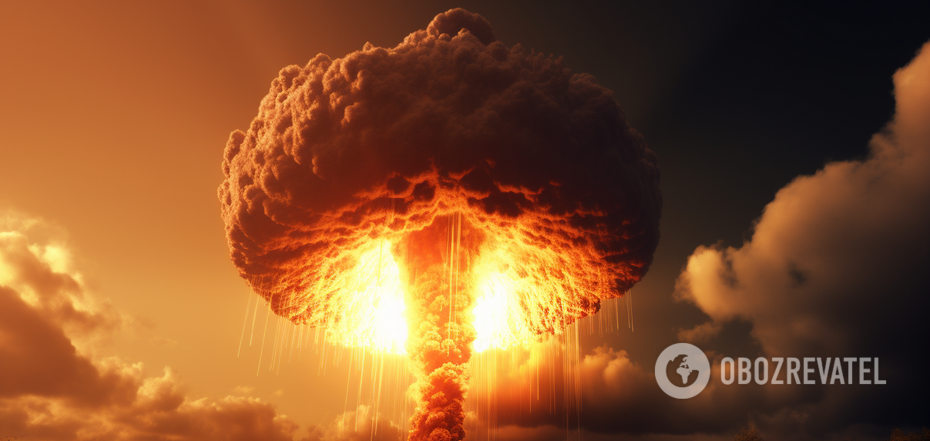Life
How to build a nuclear bomb: a (very serious) guide for those who liked Oppenheimer
On 21 July 2023, Christopher Nolan's Oppenheimer, a historical drama that tells the story of Robert Oppenheimer, the "father" of the most terrible weapon ever created by mankind - the atomic bomb. Immediately after the premiere, humorous texts about how to make a nuclear bomb began to appear online.
OBOZREVATEL will tell you how an atomic bomb works and what it takes to make one. Just don't forget the main rule of dangerous experiments - don't try to repeat it at home.
A little bit of physics
Despite the fact that the process of nuclear weapons is quite simple, it can seem like a cacophony without knowledge of the terminology. So here's what you need to know:
- atom - the building block of matter; consists of a small dense nucleus surrounded by a cloud of negatively charged particles - electrons;
- the nucleus is the centre of the atom, consisting of a number of positively charged protons and neutral neutrons that do not contain a charge;
- protons and neutrons - atoms are classified according to the number of protons and neutrons in the nucleus. The number of protons determines what chemical element the atom is (e.g., uranium), and the number of neutrons determines what isotope of that element the atom is (e.g., uranium-235);
- isotope - the isotopes of an element have the same number of protons in their nuclei but different numbers of neutrons;
- fission - a process in which the nucleus of an atom splits into smaller particles, releasing neutrons and a large amount of energy.
And, yes, an atom and a nuclear bomb are the same thing.
How to make a nuclear weapon
Of course, it's not a good idea to try to look for such things on the Internet. At least, not unless you want to meet representatives of the FBI, the SBU or the secret service of the country where you live. But to be honest, the scientific component of a nuclear bomb is not as complicated as it might seem. It's all about the components that will never be in the hands of ordinary people. Let's face it.
The main thing in making a nuclear bomb is to find the required mass of radioactive material. Everything else will happen by itself. This is called a nuclear reaction. Fortunately, it is not so easy to get radioactive material. Otherwise, every madman would have a nuclear bomb, not just the main one sitting behind the bloody walls of the Kremlin.
A nuclear device requires fissile material. Ideally, it is plutonium or uranium. In 1945, Oppenheimer and other participants in the Manhattan Project created separate bombs based on uranium 235 (U-235) and plutonium 239. Their effect is the same, so we will explain everything using uranium as an example.
Uranium is a naturally occurring heavy, slightly radioactive metal. The most common isotopes of this metal are uranium 238 (U-238) (99.27% in natural uranium) or U-235 (0.72%).
Both of these isotopes are radioactive and can decay into other elements over time. However, it is U-235 that can be forcibly split by neutrons. This is what makes a nuclear bomb "work".
Uranium enrichment
But getting U-235 is very difficult. Out of every 25,000 tonnes of uranium ore, only 50 tonnes of metal can be produced. Less than 1% of this is U-235. But you cannot deliberately extract only the isotope you need.
Therefore, you have to resort to a process of separating U-235 from U-238, which is called enrichment.
One of the most common methods involves heating uranium to a gaseous form through interaction with fluorine. This gaseous form is then spun in a centrifuge at high speed. In the process of spinning, it is conditionally "filtered" through several thousand fine-pore barriers. This makes it possible to separate uranium into two types.
The result is enriched U-235, as well as so-called depleted uranium U-238, which is used to produce conventional weapons.
Uranium fission
When a U-235 atom absorbs a neutron and splits into two new atoms, it releases three new neutrons and some binding energy. Two neutrons are absorbed by the U-238 atom and do not continue the reaction. However, one neutron collides with the U-235 atom, which fuses, releasing two neutrons and some binding energy. This time, both neutrons collide with U-235 atoms, each of which fission and release one to three neutrons, which start their work again. When enough atoms have been split, a nuclear chain reaction occurs.
Nuclear bomb
Uranium is known to be used not only for weapons but also in the energy sector. To build a nuclear reactor, uranium must be enriched so that 20% of its composition is U-235. For nuclear bombs, this figure should be closer to 80-90%.
According to various sources, the critical mass of enriched uranium required to make a nuclear bomb is 40 to 50 kg. If you don't have enough uranium, the chain reaction will not lead to an explosion.
Be careful, it's a bomb!
Of course, if you don't want the bomb to explode in your hands, you need to separate the enriched uranium from the catalyst that will start the chain reaction and trigger the nuclear explosion. That's why a nuclear bomb is divided into several separate parts, which then interact with each other using conventional explosives.
Based on the materials of The Guardian and The Atomic Heritage Foundation.
Earlier, OBOZREVATEL also told a little-known story of a Ukrainian who helped Oppenheimer create an atomic bomb.
Only verified information is available on our Obozrevatel Telegram channel, Threads and Viber. Don't fall for fakes!



























